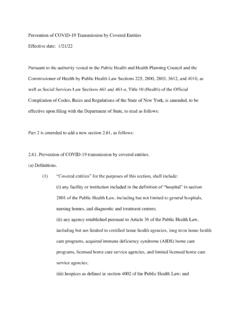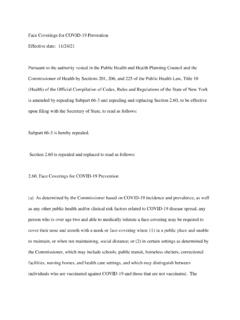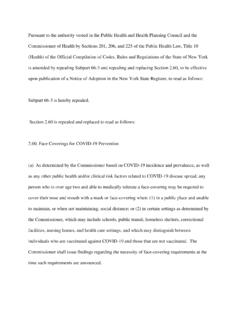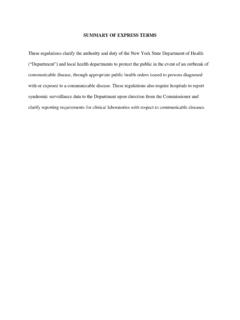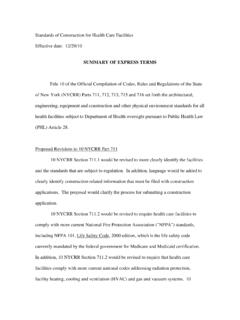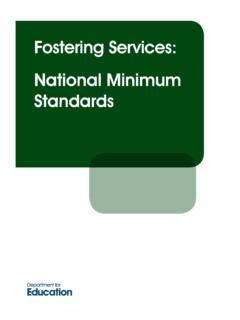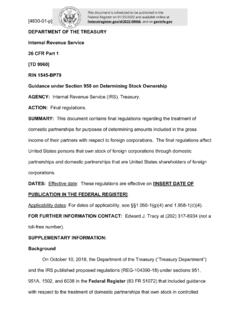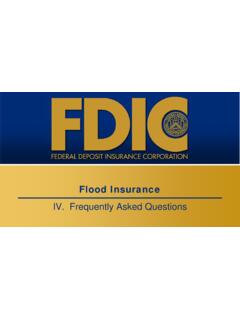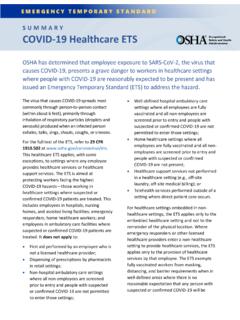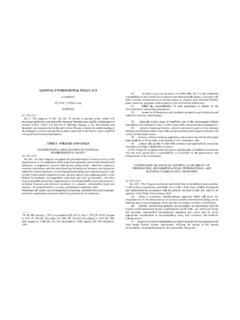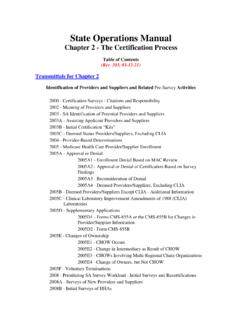Transcription of Face Coverings for COVID-19 Prevention Effective date: 8/27/21
1 Face Coverings for COVID-19 Prevention Effective date: 8/27/21 Pursuant to the authority vested in the Public Health and Health Planning Council and the Commissioner of Health by Sections 201, 206, and 225 of the Public Health Law, Title 10 (Health) of the Official Compilation of Codes, Rules and regulations of the State of New York is amended by repealing Subpart 66-3 and repealing and replacing Section , to be Effective upon filing with the Secretary of State, to read as follows: Subpart 66-3 is hereby repealed. Section is repealed and replaced to read as follows: Face Coverings for COVID-19 Prevention (a) As determined by the Commissioner based on COVID-19 incidence and prevalence, as well as any other public health and/or clinical risk factors related to COVID-19 disease spread, any person who is over age two and able to medically tolerate a face-covering may be required to cover their nose and mouth with a mask or face-covering when: (1) in a public place and unable to maintain, or when not maintaining, social distance.
2 Or (2) in certain settings as determined by the Commissioner, which may include schools, public transit, homeless shelters, correctional facilities, nursing homes, and health care settings, and which may distinguish between individuals who are vaccinated against COVID-19 and those that are not vaccinated. The 2 Commissioner shall issue findings regarding the necessity of face-covering requirements at the time such requirements are announced. (b) Businesses must provide, at their expense, face- Coverings for their employees required to wear a mask or face-covering pursuant to subdivision (a) of this section. (c) large-scale indoor event venues with more than five thousand attendees shall require patrons to wear face Coverings consistent with subdivision (a) of this section; may require all patrons to wear a face covering irrespective of vaccination status; and may deny admittance to any person who fails to comply.
3 This regulation shall be applied in a manner consistent with the federal American with Disabilities Act, New York State or New York City Human Rights Law, and any other applicable provision of law. (d) No business owner shall deny employment or services to or discriminate against any person on the basis that such person elects to wear a face-covering that is designed to inhibit the transmission of COVID-19 , but that is not designed to otherwise obscure the identity of the individual. (e) For purposes of this section face- Coverings shall include, but are not limited to, cloth masks, surgical masks, and N-95 respirators that are worn to completely cover a person s nose and mouth. (f) Penalities and enforcement. (i) A violation of any provision of this Section is subject to all civil and criminal penalties as provided for by law.
4 Individuals or entities that violate this Section are subject to a maximum fine of $1,000 for each violation. For purposes of civil penalties, each day that an entity operates in a manner inconsistent with the Section shall constitute a separate violation under this Section. 3 (ii) All local health officers shall take such steps as may be necessary to enforce the provisions of this Section accordance with the Public Health Law and this Title. 4 REGULATORY IMPACT STATEMENT Statutory Authority: The statutory authority for adding a new Section is sections 201, 206, and 225 of the Public Health Law. Legislative Objectives: The legislative objective of PHL 201 includes authorizing the New York State Department of Health ( Department ) to control and promote the control of communicable diseases to reduce their spread.
5 Likewise, the legislative objective of PHL 206 includes authorizing the Commissioner of Health to take cognizance of the interests of health and life of the people of the state, and of all matters pertaining thereto and exercise the functions, powers and duties of the department prescribed by law, including control of communicable diseases. The legislative objective of Public Health Law 225 is, in part, to protect the public health by authorizing PHHPC, with the approval of the Commissioner, to amend the State Sanitary Code to address public health issues related to communicable disease. Needs and Benefits: The 2019 Coronavirus ( COVID-19 ) is a disease that causes mild to severe respiratory symptoms, including fever, cough, and difficulty breathing. People infected with COVID-19 have had symptoms ranging from those that are mild (like a common cold) to severe pneumonia that requires medical care in a general hospital and can be fatal, with a disproportionate risk of severe illness for older adults and/or those who have serious underlying medical health conditions.
6 5 On January 30, 2020, the World Health Organization (WHO) designated the COVID-19 outbreak as a Public Health Emergency of International Concern. On a national level, the Secretary of Health and Human Services determined on January 31, 2020 that as a result of confirmed cases of COVID-19 in the United States, a public health emergency existed and had existed since January 27, 2020, nationwide. Thereafter, the situation rapidly evolved throughout the world, with many countries, including the United States, quickly progressing from the identification of travel-associated cases to person-to-person transmission among close contacts of travel-associated cases, and finally to widespread community transmission of COVID-19 . New York State first identified cases on March 1, 2020 and thereafter became the national epicenter of the outbreak.
7 On March 7, 2020, with widespread transmission rapidly increasing within certain areas of the state, Governor Andrew M. Cuomo issued an Executive Order declaring a state disaster emergency to aid in addressing the threat COVID-19 poses to the health and welfare of New York State residents and visitors, which ended on June 24, 2021, due to the success in vaccination rates, and declining hospitalization and positivity statewide. With the emergence of the Delta variant, a strain twice as transmissible as the SARS-CoV-2 strain, this does not mean that COVID-19 is gone. Cases have risen 10-fold since early July, with the Delta variant accounting for 95% of recent sequenced positives in New York State. These regulations update previously filed emergency regulations to provide that masking may be required under certain circumstances, as determined by the Commissioner based on COVID-19 incidence and prevalence, as well as any other public health and/or clinical risk factors related to COVID-19 disease spread.
8 6 COSTS: Costs to Regulated Parties: As part of ongoing efforts to address the COVID-19 pandemic, regulated parties have been a partner in implementing measures to limit the spread and/or mitigate the impact of COVID-19 within the state since March of 2020. Accordingly, this regulation does not impose additional costs to regulated parties. Costs to Local and State Governments: State and local government are authorized to enforce civil and criminal penalties related to the violation of these regulations , and there may be some cost of enforcement, however such costs are anticipated to be minimal as these provisions continue existing enforcement requirements. Paperwork: This regulation imposes no additional paperwork. Local Government Mandates: As part of ongoing efforts to address the COVID-19 pandemic, local governments have been a partner in implementing and enforcing measures to limit the spread and/or mitigate the impact of COVID-19 within their jurisdictions since March of 2020.
9 Further, local governments have separate authority and responsibilities to control disease within their jurisdictions pursuant to PHL sec. 2100 and Part 2 of the State Sanitary Code. 7 Duplication: There is no duplication of federal law. Alternatives: The alternative would be to not promulgate these emergency regulations . However, this alternative was rejected, as the Department believes this regulation will facilitate the Department s ability to respond to the evolving nature of this serious and ongoing communicable disease outbreak. Federal Standards: States and local governments have primary authority for controlling disease within their respective jurisdictions. Accordingly, there are no federal statutes or regulations that apply to disease control within NYS. Compliance Schedule: The regulations will become Effective upon filing with the Department of State and will expire, unless renewed, 90 days from the date of filing.
10 As the COVID-19 pandemic is consistently and rapidly changing, it is not possible to determine the expected duration of need at this point in time. The Department will continuously evaluate the expected duration of these emergency regulations throughout the aforementioned 90-day Effective period in making determinations on the need for continuing this regulation on an emergency basis or issuing a notice of proposed ruling-making for permanent adoption. This notice does not constitute a notice of proposed or revised rule making for permanent adoption. 8 Contact Person: Katherine Ceroalo New York State Department of Health Bureau of Program Counsel, Regulatory Affairs Unit Corning Tower Building, Room 2438 Empire State Plaza Albany, New York 12237 (518) 473-7488 (518) 473-2019 (FAX) 9 REGULATORY FLEXIBILITY ANALYSIS Effect on Small Business and Local Government: As part of ongoing efforts to address the COVID-19 pandemic, businesses and local government have been a partner in implementing measures to limit the spread and/or mitigate the impact of COVID-19 within the state since March of 2020.
